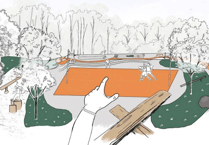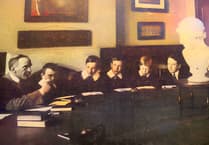The Chase Wheel
A local resident has been very concerned since learning that the Chase Hotel was to close about the preservation of what he believes could be an important part of Ross’s industrial heritage.
One of the key factors in Britain’s Industrial Revolution was the early development of water power. Not just on the great rivers like the Humber, Mersey, Thames and Severn, all major arteries in the commercial prosperity of the nation. Nor the canals which began to spring up in the 18thC as a spur to commerce and communication throughout the land. The little rivers too played a vital part.
In Sheffield there are examples of water-powered industrial workshops along the relatively unknown River Porter. The Porter is little more than a stream, bubbling along over rills and stones in the Western approaches to the city. It is small, shallow and safe enough for children to paddle in, the water rarely reaching much above the children’s ankles. And yet this stream provided power for industrial workshops along two miles of its length producing the blades and tools that were to make the City of Sheffield famous. Other rivers in the city also provided the energy for the burgeoning industry.
In Ross on Wye another river runs through the town apart from the Wye which made the town famous; the aptly named Smallbrook, little more than a gentle, shallow stream. So how does the Smallbrook come to be so important? From where does it (and others like Sheffield’s Porter) derive its power? How do these trickling streams have the energy to drive mighty iron water wheels?
The System
Left alone the stream would simply flow over, under and round the paddles (or ‘blades’) of a mill-wheel, (unlike the Severn at Tewkesbury, the power of whose flow can be harnessed with relatively little aid beyond a sluice gate). But with the streams like Smallbrook and the Porter something else was needed.
The answer came with the building of small lakes (millponds) into which the stream flowed before continuing. At the downstream end of the pond the water was released to continue on its way. But the exit flow was regulated by a sluice gate which could be raised or lowered to release or contain the water. To prevent flooding a weir was constructed at an optimum height adjacent to the sluice, over which the outlet flow of the river could continue when the sluice gate was closed.
However the millpond now contains some millions of gallons of water, whose only outlet was either to flow at the river’s normal pace over the weir – or (and this is where the stored energy in the little stream becomes potent) – by opening the sluice gate the water poured from the pond in unbelievable force onto the paddles of the millwheel immediately below the sluice! The engineering, even in the eighteenth century was such that a perfectly balanced iron wheel 12 feet in diameter would be unable to resist the constant force of water and begin to revolve. Connected by shafts and gears to the adjacent workshop, trip-hammers could be raised and dropped to forge blades on an anvil. Corn could be ground. The forerunners of the later ‘manufacturies’ were thus created and industrialisation began.
Along a two mile stretch of Sheffield’s tiny River Porter there is a series of six millponds with the remains of their water mills and sluices, each fed in a turn by the same water released from the one before. No water polluted and none lost whilst the flow of the river continued. Perfect ‘Green’ energy.
The ‘Chase’ Wheel.
There is a move to have the grounds of the Chase Hotel designated as LOCAL GREEN SPACE in the Ross Neighbourhood Development Plan. Its beauty, tranquillity, wildlife etc are vital and valid reasons for preserving this area which has stood as a haven untouched for at least eighty years. But there is another important reason of local historical significance.
The pond in the hotel grounds fed by the Smallbrook is an important part of Ross’s industrial heritage. At the downstream end of ‘The Chase’ park where the stream falls to flow beneath Gloucester Road there is the remnants of an old water wheel and millrace. Beside the wheel are the workings of the original sluice gate to control the water flow, and on the opposite side of the wheel there remains the stone construction of the overflow channel from the weir. Clearly this was some sort of mill. Was it used in food production? - or perhaps as part of a craft workshop producing tools and implements in bygone days. At all events it is a site of significant industrial architectural interest. I have seen similar millponds and workshops preserved and restored as sites of major importance in the historical infrastructure of Sheffield, (ie The Shepherd’s Wheel on the Porter River, identified as going back to the beginning of the Industrial Revolution – it has been restored). Maybe Ross had its part to play too. At all events The Chase wheel is too important to lose.
The way forward?
I believe it is important for the site to be undisturbed until an examination has been carried out by Industrial Archealogists to determine its origin.
ie:
What was the mill used for? Did it form part of the assets of the original ‘Chase’ estate; maybe as a source of income for the original owner? (There is a precedent for thinking this; on the Chatsworth estate in Derbyshire, a mile or so distant from Chatsworth House there stands a ruined mill on the banks of the River Derwent which presumably contributed to the fortunes of the then Dukes of Devonshire in the 18th century.
So! is the lake in the Chase grounds natural, or was it constructed with the sole purpose of harnessing the latent power in the Smallbrook to enable a viable mill to be established in the Chase grounds. There may be evidence of artificial banks being constructed around the lake.
In particular:
The site and ruined works could form a neglected part of Ross’s industrial heritage. If so, it should be preserved and some restoration by persons qualified in this field considered.
At all events the site should not be disturbed or compromised in any way.
Perhaps old records or maps exist to throw further light on the site. (Civic Society?) It may reveal a hitherto unknown aspect of Ross’s history.
I contacted English Heritage seeking their opinion. They expressed interest but now the hotel is closed, and what will happen to The Wheel? I have since learned it was used to pump fresh water up to the house (there are the remnants of ‘linkage’ to drive a pump attached to the old workings. A bit like the links that drive the cylinders on old railway trains).
Standing in an overgrown and neglected corner of The Chase grounds can this important artefact survive The Chase development? Is there evidence of the fresh water outlet from the wheel pump still up in the house? And buried water pipelines from the mill to the house – are they still in existence?
Does it really matter?
Does anybody care?
Brian Jackson.




